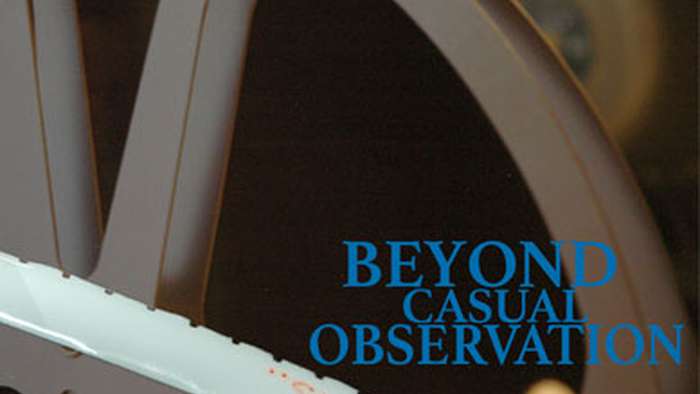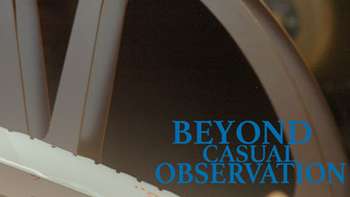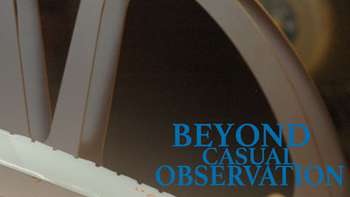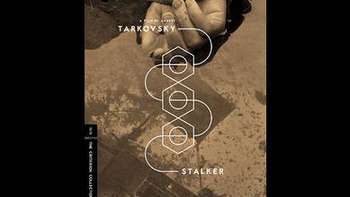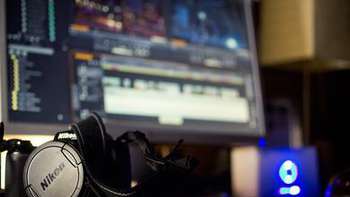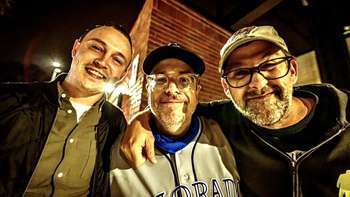In this installment of Beyond Casual Observation the moving picture becomes a partner with technological advancements and forges an enduring storytelling medium.
Filmmaking is a conversation. A conversation between the viewer and the filmmaker. A conversation between characters. Among the elements that a filmmaker uses to communicate information with the viewer might be detail in the physical set, control of the physical space, or sound within or outside of the frame. The convergence of many storytelling elements delivered via film or tv hopefully creates a deep singular experience. Beyond Casual Observation isolates sound, looks at work for its sound elements (scores, songs lists, sound design), and talks to professionals about their creative process in the aural sphere.
Artists and innovators have been pushing the possibilities of image and sound since the very emergence of those mediums. Early efforts to stimulate the senses through the arts have been preserved and function as a referential and retrospective function for creativity and innovation. The communication between artists and audiences, and the concurrent need for tools to improve and expand that communication, has helped the arts move forward and endeared us to the past.
Just this week I was listening to the Soundworks Podcast (a recommended podcast for both film lovers and creatives) and in an episode featuring Pete Horner the topic of Francis Coppola’s influences for Apocalypse Now is discussed.
A clip from an interview with Coppola is played within the episode and mentions the musician Isao Tomita, whom he originally wanted to score Apocalypse. The influence that Tomita had on how Coppola and the creative team on Apocalypse Now imagined and conceived the sound of the film is profound.
The Apocalypse Now team would eventually innovate 5.1 surround sound and open doors for future sound artists. From the need to amplify the sound elements to tell the story, that team changed the filmmaking world, and paved the way for immersive visual experiences.
Sounds and music provide information about the world we are introduced to in a film or television show. In Apocalypse Now the spatial sense normally established by the frame, i.e. characters moving on and off screen or an object landing in frame, was expanded when a helicopter out of frame could be heard before the dust on the ground in the frame started blowing. Today, in 2019, the visual tables have literally turned further and a 360 degree visual view is delivered through VR technology. Like a live music show brings us closer to the intentions and energy of musicians, sound in film brings us closer, complements and accentuates the storytelling elements in film or television.
A quick, basic example to illustrate the depth and gravity of this point of this is the story of the Halloween theme from John Carpenter’s 1978 film.
The score for Halloween provided an essential accompaniment to the film’s setting and mood, and is forever associated with the primary antagonist and a film series. While synth music had been around, we can look back at it now for its ascent in the 1980s and the aesthetic therein. Today, Stranger Things and American Horror Story are among those who use this association on their shows.
Using uniquely crafted sounds, filmmakers can present a world we have never experienced and calibrate us, the audience. We can be eased into a mood to be in with a score, and capture the sway of our antagonists and protagonists much like the killer and terrorized kids in Carpenter's Halloween. I love what Hans Zimmer said about the incomplete scales in Man of Steel as they related directly to the character. As intense and pounding as the Man of Steel score is, parts of it play scales nearly -- but not quite -- to completion and convey the unfinished journey of Clark Kent. As heroic as the Man of Steel score is, it takes into account the journey of its main character by using musical language to communicate his plight.
Johnny Greenwood’s score for There Will Be Blood pins the world of Daniel Plainview to our tweed lapel.
The music in There Will Be Blood is never far away and seamlessly accompanies the life of Plainview, his successes, and his failures. The music is a menacing, nefarious character. The score looms, like an overseer or puppeteer. It paces drama, and gives us an emotional and mental state of the characters. The music breaks us down emotionally, and throughout the film gives tells us when to calm down from the storm on screen. There are times that I think the score alludes to the gloomy real life consequences of the human conditions and experiences portrayed on screen.
In 1995’s Heat, Moby created a soundscape, like a bubble, for us to enter the city not unlike the opening shot itself which delivers us, and Neil McCauley to one final stop. The score for Heat is a marvelous, seemingly contrary, motif. A sleek, smooth beast to the gritty realism on screen. The sound is in the action. most notably demonstrated by the gunfire in the film’s longest heist scene. The sound of gunfire has weight because gunfire has consequences; gunfire is serious. The reverb gained by emptying the streets in filming provides much of the spatial placement that Apocalypse’s field sounds did, and also underscores the intention of Michael Mann and his team to present that heist like a documented event. Reverb as an organic effect became an essential component of telling that moment of the story because it intensifies the experience of the characters as we, the audience, perceive it when we watch it. Moby's theme exists more "of" the film, than in the film, that is until the very end where the film presents the weight of the film's themes in one scene: the consequence of human action.
That is our sound scape, and it is our connection to the world that Mann and his team create. That sleek, smooth beast is a marvelous expression of the moving pieces in Heat’s metropolis, the entanglement of our lives, the ripples, the waves and, ultimately, the loneliness in goodbyes amidst the turmoils. That implementation of music is no accident; that is intention. That is the strength of sound. Sound is not an argument against picture. Sound is the other side of the barbell seeking to move intentionally under the weighted elements of visual storytelling in film and television. That conversation must be words in person or on paper is only one form of conversation. The conversations we have with one another as audiences, or conversations filmmakers are having with us are attempts to connect with something and that may be the heaviest conversation of all.
We started “Beyond Casual Observation" in 2012 to explore the presence of sound in film. It is a fun and exciting topic. Soundtracks and scores are increasingly easier to get our hands on. Over the course of seven years we spoke to professionals in the field to understand their creative process, and through these exchanges people graciously offered insight that complimented each piece. In those ways this series fit in with interviews and features with musicians and about music. The goal was to reach more readers and broaden our topic set for current readers. It was fun and I thank everyone who took the time to read, participate and share thoughts.
